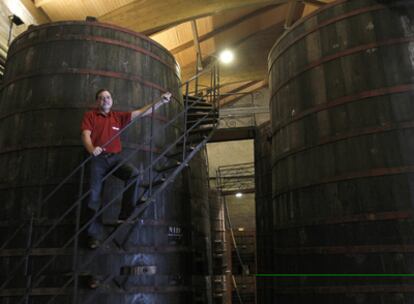Vat man forever
Master barrel maker Jesús Azcárate Mora of the Muga winery is the last exponent of an ancient art
This autumn's grape harvest was at its height and the Estación neighborhood of Haro (La Rioja) - which should really be renamed the wine neighborhood due to the large number of bodegas crowded into it - is in a state of ferment. In one unique winery, Muga, stands a bastion of traditional craftsmanship: Spain's last cubero (barrel maker), the only person who still builds barrels by hand and finishes them with the naked eye, as the canons dictate.
He is Jesús Azcárate Mora, and is also nicknamed "The Navarran" owing to the origins of his father, Jesús Azcárate Garde, with whom he started working in San Vicente de la Sonsierra in 1974 when he was 16. Now he is 53. His profession runs in the family. Jesús senior learned the trade from his father-in-law, Julián Mora, who had inherited it from his ancestors. Now he wants to enlist his second-born son, also named Jesús, into the trade. He already has a good eye.
The skill is in calculating "with no mathematics" the number of boards needed
Now Jesús wants to enlist his son, who already has a good eye, into the trade
The Azcárates used to make barrels for the many wineries in La Rioja and other parts - the last barrel maker's first job was in Jerez de la Frontera - until technological progress led to the substitution of wood for modern, stainless steel. Now wooden barrels are almost relics, although their longevity means they can be used for hundreds of years.
So the death knell has sounded for the barrel-making trade. Azcárate senior had to close his workshop, although his son, probably because of the Muga family's determination to persist in the wooden-barrel business, started working exclusively for the winery from 1987. And, 13 years ago, he set himself up as right-hand man and guardian of the Muga house, where his wife Nieves Díaz de Medina, is in charge of the kitchen.
"Isaac Muga was like a second father to me. I used to tell him things that I wouldn't tell anyone else," says Azcárate, an affable and discreet man who lives for his profession. He has also become a seasoned wine taster, probably due to all the time he spent with Isaac, with whom he used to go out on patrol around La Herradura (Haro's wine street).
If, as a unique specimen, the last barrel maker feels like an orphan, he doesn't show it. "It's a difficult trade and as the wineries buy the barrels and casks in series, it gets less attractive," he says. In Muga he works with carpenters and an apprentice. Although the machinery is vital for working with the very heavy materials, the labor is manual and consists in cutting the planks that form the wall of the barrel and baking them to create the recipient's form, which according to the shape and size, can be categorized as a cask, vat or keg.
Perhaps because of his barrel maker's pride, Azcárate likes to explain the difference. A cask is oval and is placed horizontally while the vat looks like a truncated cone. Both can carry over 1,000 liters. The kegs are also oval but have a standard volume of 225 liters. The Navarran, who began to make casks when he joined Muga, explains that those who make barrels and vats are cuberos, while those who make kegs are toneleros (coopers). "There are lots of cooper workshops in Spain, both industrial and traditional; but no barrel makers."
The ability of a good barrel maker is best seen in the vats and casks. The skill is in precisely calculating "with no mathematics" the number of boards needed to close the circumference. It is not always the same (typically between 28 and 32 in a keg), nor do they have the same width. "It's likely the end result is not perfectly equal as in industrial manufacturing. Here the important thing is the wood that we put in place with our hands," he explains.
In the Muga workshop they make 700 kegs a year (and order another 700, made from the same French oak but brought in from outside) and a number of casks and vats, according to what needs to be replaced. "A 20,000-liter vat can take us four weeks," he says. The process of producing and ageing wine gets more and more mechanized every day, but the eye of a good barrel maker resists saying good bye.

Tu suscripción se está usando en otro dispositivo
¿Quieres añadir otro usuario a tu suscripción?
Si continúas leyendo en este dispositivo, no se podrá leer en el otro.
FlechaTu suscripción se está usando en otro dispositivo y solo puedes acceder a EL PAÍS desde un dispositivo a la vez.
Si quieres compartir tu cuenta, cambia tu suscripción a la modalidad Premium, así podrás añadir otro usuario. Cada uno accederá con su propia cuenta de email, lo que os permitirá personalizar vuestra experiencia en EL PAÍS.
¿Tienes una suscripción de empresa? Accede aquí para contratar más cuentas.
En el caso de no saber quién está usando tu cuenta, te recomendamos cambiar tu contraseña aquí.
Si decides continuar compartiendo tu cuenta, este mensaje se mostrará en tu dispositivo y en el de la otra persona que está usando tu cuenta de forma indefinida, afectando a tu experiencia de lectura. Puedes consultar aquí los términos y condiciones de la suscripción digital.
Últimas noticias
Festival Luces de Invierno: qué actividades se esperan y horario de los conciertos en el Zócalo de Ciudad de México
Las nuevas imágenes de Epstein publicadas por el Departamento de Justicia de Estados Unidos
Seis playas en México en donde no es seguro nadar en las vacaciones de invierno, alertan Semarnat y Cofepris
Un Barcelona de récord y líder gana al Baskonia un partido para la historia: 134-124
Lo más visto
- El Supremo condena a ‘Okdiario’ y a Eduardo Inda por intromisión en el honor de Iglesias al acusarle de cobrar de Venezuela
- Los pagos del Gobierno de Ayuso a Quirón engordan con facturas de hace una década y sin pagar desde tiempos de Cifuentes
- Más de 40 congresistas demócratas piden por carta a Trump que cese en sus “intentos de socavar la democracia en Brasil”
- La princesa Leonor realiza su primer vuelo en solitario como parte de su formación en el Ejército del Aire
- Última hora de la actualidad política, en directo | Gallardo: “Guardiola no quiso ir al debate ayer porque no podía hablar bien de lo que ha hecho a lo largo de estos dos años y medio”




























































